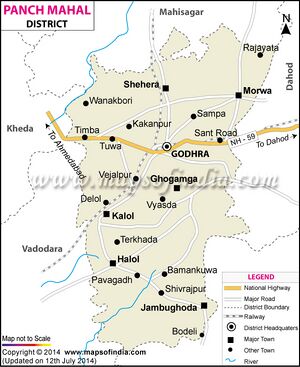Champaner
| Author:Laxman Burdak, IFS (R) |

Champaner (Hindi:चांपानेर, Gujarati: ચાંપાનેર) is a historical city in the state of Gujarat, India. Champaner is today the site of the Champaner-Pavagadh Archaeological Park, which UNESCO designated a World Heritage Site in 2004.
Variants
- Chanpaner (चांपानेर) = चंपानेर (गुजरात) (AS, p.331)
- Champanagara चम्पानगर = Champapura चम्पापुर = Champa चम्पा (1), 2. Champaner (चांपानेर) (AS, p.322)
- Champaneraka (चंपानेरक) (AS, p.331)
- Muhammadpur
- Pavagadh /Pavagadha पावागढ़, दे. Champaner चांपानेर, (AS, p.555)
Location
It is located in Panchmahal district, 47 kms from the city of Vadodara.
Origin
It got name after Vanraj Chavda's friend and general Champa, also known later as Champaraj.
History
The city was briefly the capital of the Sultanate of Gujarat. It was founded by Vanraj Chavda, the most prominent king of the Chavda Dynasty, in the 8th century. He named it after the name of his friend and general Champa, also known later as Champaraj.
By the later 15th century, the Khichi Chauhans held Pavagadh fort above the town of Champaner. The young Sultan of Gujarat, Mahmud Begada, deciding to attack Champaner, started towards it with his army on 4 December 1482. After defeating the Champaner army, Mahmud captured the town and besieged Pavagadh, the well-known hill-fortress, above Champaner, where king Jayasimha had taken refuge. He captured the Pavagadh fort on 21 November 1484, after a siege of 20 months.[1] He then spent 23 years rebuilding and embellishing Champaner, which he renamed Muhammadabad,[2] after which he moved the capital there from Ahmedabad. In 1535, after chasing away Bahadur Shah, Humayun led 300 Mughals to scale the fort on spikes driven into rock and stonework in a remote and unguarded part of the citadel built over a precipitous hillside on Pavagadh Hill. Large heaps of gold, silver and jewels were the war bounty even though Bahadur Shah had managed to escape with a lot to Diu [3]
Sultan Begada also built a magnificent Jama Masjid in Champaner, which ranks amongst the finest architectural edifices in Gujarat. It is an imposing structure on a high plinth, with a central dome, two minarets 30 meters in height, 172 pillars, seven mihrabs, and carved entrance gates with fine latticed windows called "jalis".
चांपानेर = चंपानेर
विजयेन्द्र कुमार माथुर[4] ने लेख किया है ... चांपानेर (AS, p.331): चांपानेर अथवा 'चंपानेर' गुजरात में बड़ौदा से 21 मील (लगभग 19.2 कि.मी.) और गोधरा से 25 मील (लगभग 40 कि.मी.) की दूरी पर स्थित है। गुजरात की मध्ययुगीन राजधानी चांपानेर, जिसका मूल नाम 'चंपानगर' या 'चंपानेर' था, के स्थान पर वर्तमान समय में पावागढ़ नामक नगर बसा हुआ है। यहाँ से चांपानेर रोड स्टेशन 12 मील (लगभग 19.2 कि.मी.) है। इस नगर को जैन धर्म ग्रन्थों में तीर्थ स्थल माना गया है। जैन ग्रन्थ 'तीर्थमाला चैत्यवदंन' में चांपानेर का नामोल्लेख है- 'चंपानेरक धर्मचक्र मथुराऽयोध्या प्रतिष्ठानके -।'
प्राचीन चांपानेर नगरी 12 वर्ग मील के घेरे में बसी हुई थी। पावागढ़ की पहाड़ी पर उस समय एक दुर्ग भी था, जिसे पवनगढ़ या पावागढ़ कहते थे। यह दुर्ग अब नष्ट-भ्रष्ट हो गया है, पर प्राचीन महाकाली का मंदिर आज भी विद्यमान है। चांपानेर की पहाड़ी समुद्र तल से 2800 फुट ऊँची है। इसका संबंध ऋषि विक्रमादित्य से बताया जाता है। चांपानेर का संस्थापक गुजरात नरेश वनराज का चंपा नामक मंत्री था। चांदबरौत नामक गुजराती लेखक के अनुसार 11वीं शती में गुजरात के शासक भीमदेव के समय में चांपानेर का राजा मामगौर तुअर था। 1300 ई. में चौहानों ने चांपानेर पर अधिकार कर लिया। 1484 ई. में महमूद बेगड़ा ने इस नगरी पर आक्रमण किया और वीर राजपूतों ने विवश होकर अपने प्राण शत्रु से लड़ते-लड़ते गवां दिए। रावल पतई जयसिंह और उसका मंत्री डूंगरसी पकड़े गए और इस्लाम स्वीकार न करने पर मुस्लिम आक्रांताओं ने 17 नवंबर, 1484 ई. में उनका वध कर दिया। इस प्रकार चांपानेर के 184 वर्ष के प्राचीन राजपूत राज्य की समाप्ति हुई।
मुग़लों का अधिकार: 1535 ई. में मुग़ल बादशाह हुमायूँ ने चांपानेर दुर्ग पर अधिकार कर लिया, पर यह आधिपत्य धीरे-धीरे शिथिल होने लगा और 1573 ई. में अकबर को नगर का घेरा डालना पड़ा और उसने फिर से इसे हस्तगत कर लिया। इस प्रकार संघर्षमय अस्तित्व के साथ चांपानेर मुग़लों के कब्जे में प्राय: 150 वर्षों तक रहा। 1729 ई. में सिंधिया का यहाँ अधिकार हो गया और 1853 ई. में अंग्रेज़ों ने सिंधिया से इसे लेकर बंबई (वर्तमान मुम्बई) प्रांत में मिला दिया। वर्तमान चांपानेर मुस्लिमों द्वारा बसाई गई बस्ती है। राजपूतों के समय का चांपानेर यहाँ से कुछ दूर है।
स्थापत्य': गुजरात के सुलतानों ने चांपानेर में अनेक सुंदर प्रासाद बनवाए थे। ये सब अब खंडहर हो गए हैं। 'हलोल' नामक नगर, जो बहुत दिनों तक संपन्न और समृद्ध दशा में रहा, चांपानेर का ही उपनगर था। इसका महत्व गुजरात के सुलतान बहादुरशाह की मृत्यु के पश्चात् (16वीं शती) समाप्त हो गया। पहाड़ी पर
[p.332]: जो काली मंदिर है, वह बहुत प्राचीन है। कहा जाता है कि विश्वामित्र ने उसकी स्थापना की थी। इन्हीं ऋषि के नाम से इस पहाड़ी से निकलने वाली नदी 'विश्वामित्री' कहलाती है। महादजी सिंधिया ने पहाड़ी की चोटी पर पहुँचने के लिए शैलकृत सीढ़ियाँ बनवाईं थीं। चांपानेर तक पहुँचने के लिए सात दरवाजों में से होकर जाना पड़ता है।
External links
References
- ↑ Majumdar, R.C. (ed.) (2006). The Delhi Sultanate, Mumbai: Bharatiya Vidya Bhavan, pp.164-5
- ↑ Sen, Sailendra (2013). A Textbook of Medieval Indian History. Primus Books. p. 115. ISBN 978-9-38060-734-4.
- ↑ The Mughal Throne by Abraham Eraly, pg 44
- ↑ Aitihasik Sthanavali by Vijayendra Kumar Mathur, p.331

